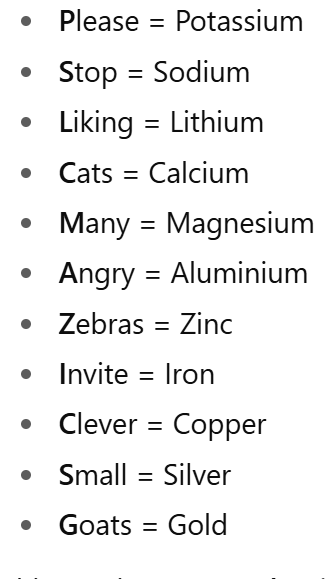Inorganic Chemistry
1/13
There's no tags or description
Looks like no tags are added yet.
Name | Mastery | Learn | Test | Matching | Spaced |
|---|
No study sessions yet.
14 Terms
Know the Reactivity Series
Potassium, Sodium, Lithium, Calcium, Magnesium, Aluminium, Zinc, Iron, Copper, Silver, Gold

When does rusting of iron occur?
When water and oxygen are present
How can rusting be prevented?
Barrier Method (Painting/Oiling) , Sacrificial Protection, Galvanising
Explain the Barrier Method (Painting/Oiling)
The barrier method involves painting a protective layer, such as paint or oil, to iron surfaces to prevent it coming into contact with water and oxygen. However, if the coatings are washed away or scratched, the iron is once again exposed to water and oxygen and will rust, once iron begins to rust it will continue to corrode internally as rust is porous and allows both air and water to come into contact with fresh metal underneath.
Explain Sacrificial Protection
This prevents iron from rusting through the reactivity series where a more reactive metal can be attached to a less reactive metal. The more reactive metal will oxidize and corrode first, protecting the less reactive metal from corrosion. The more reactive metal will lose electrons more easily and is oxidized more easily. For continued protection the more reactive metal needs to be replaced before the completely corrode.
Explain Galvanization
The iron is covered with zinc, this can be done by electroplating or dipping it. If the coating is damaged or scratched the iron is still protected through sacrificial protection.
Where are reactive metals found?
Reactive metals are found in ores where they are usually chemically combined with other substances found in the earth’s crust. These need to be extracted chemically with processes such as electrolysis or reduction with carbon.
How are unreactive metals usually found?
They are usually found as an uncombined element. These do not have to be extracted chemically.
Uses of High carbon Steel and main property
Tools and chisels - Very hard
Uses and main property of Low Alloy Steel
Construction Bridges, high speed tools - Hard and strong, Low malleability and ducitility
Uses and main property of Stainless Steel
Cutlery, Sinks, Chemical Plants - Strong and resistant to corrosion
Explain properties of aluminum and its uses
Aircraft Bodies - High strength-to-weight ratio (low density)
Saucepans - Unreactive and good conductor of heat
Food cans - Non-toxic, resistant to corrosion and acidic food stuffs
Explain properties of copper and its uses
Electrical wiring - very good conductor of electricity and ductile
Saucepans - Good conductor of heat, unreactive and malleable
Water pipes - Unreactive and non-toxic
Explain properties of iron and its uses
Building material - Good strength, malleable and ductile
Catalyst - Increases rate of reaction without being used up